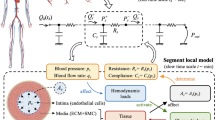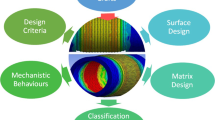Abstract
Stent implants are essential in restoring normal blood flow in atherosclerotic arteries. Recent studies have shown high failure rates of stent implants in superficial femoral artery (SFA) as a result of dynamic loading environment imposed on the stent implants by the diseased arterial wall and turbulent blood flow. There are variety of stent designs and materials currently on the market however, there is no clear understanding if specific stent design is suitable with the material that is manufactured from and if this combination can sustain the life-cycle that the stent implants need to undergo once inside the artery. Lack of studies have been presented that relate stent mechanical properties with stent geometry and material used. This study presents linear theoretical and computational modeling approach that determines stent mechanical properties with effective stiffness of the deployed stent. Effective stiffness of the stent has been accurately derived based on stent structure design and loading in axial and radial directions. A rhombus stent structure was selected for this study due to its more common use and produced by main stream manufacturers. The derived theoretical model was validated using numerical finite element modeling approach. Results from this study can lead to preliminary insight towards understanding of stent deformation based on stent geometry, material properties and artery wall pressure; and how to carefully match stent’s geometry with suitable material for long life cycle, increased strength, and reliable performance of stent implants.








Similar content being viewed by others
References
Ansari, F., L. K. Pack, S. S. Brooks, and T. M. Morrison. Design considerations for studies of the biomechanical environment of the femoropopliteal arteries. J. Vasc. Surg. 58(3):804–813, 2013.
Auricchio, F., A. Constantinescu, and G. Scalet. Fatigue of 316L stainless steel notched [mu] m-size components. Int. J. Fatigue 68:231–247, 2014.
Banerjee, S., T. S. Das, M. S. Abu-Fadel, E. J. Dippel, N. W. Shammas, D. L. Tran, A. Zankar, C. Varghese, K. C. Kelly, R. A. Weideman, B. B. Little, R. F. Reilly, T. Addo, and E. S. Brilakis. Pilot trial of cryoplasty or conventional balloon post-dilation of nitinol stents for revascularization of peripheral arterial segments-the COBRA trial. J. Am. Coll. Cardiol. 60(15):1352–1359, 2012.
Boston Scientific. Express Stent by Boston Scientific. http://www.bostonscientific.com/en-US/products/stents–vascular/Express_LD_Iliac_and_Biliary_Stent_System/Express-LD-Iliac-and-Biliary-Stent-System.html. Accessed April 2016.
Cheng, C., G. Choi, R. Herfkins, and C. A. Taylor. The effect of aging on deformations of the superficial femoral artery resulting from hip and knee flexion: potential clinical implications. J. VascInterv. Radiol. 21:195–202, 2010.
Cheng, C., N. M. Wilson, R. L. Hallett, R. J. Herfkens, and C. A. Taylor. In-vivo MR angiographic quantification of axial and twisting deformations of the superficial femoral artery resulting from maximum hip and knee flexion. J. VascInterv. Radiol. 17:979–987, 2006.
Choi, G., C. P. Cheng, N. M. Wilson, and C. A. Taylor. Methods for quantifying three-dimensional deformation of arteries due to pulsatile and non- pulsatile forces: implications for the design of stents and stent grafts. Ann. Biomed. Eng. 27:14–33, 2009.
Etave, F., G. Finet, M. Boivin, J. C. Boyer, G. Rioufol, and G. Thollet. Mechanical properties of coronary stents determined by using finite element analysis. J. Biomech. 34:1065–1075, 2001.
Fortier, A., V. Gullapalli, and R. A. Mirshams. Review of biomechanical studies of arteries and their effect on stent performance. Int. J. Cardiol. 4:12–18, 2014.
Garasic, J. M. Stent and artery geometry determine intimal thickening independent of arterial injury. Circulation 101:812–818, 2000.
Graeham, R., A. Douglas, and S. Phani. Analyses and design of expansion mechanisms of balloon expandable vascular stents. J. Biomech 6:1438–1446, 2014.
Kalpakjian, S., and S. R. Schmid. Manufacturing Engineering and Technology (6th ed.). Englewood Cliffs, NJ: Prentice Hall, 2010.
Karnessis, N., and G. Burriesci. Uniaxial and buckling mechanical response of auxetic cellular tubes. Smart Mater. Struct. 22:084008, 2013.
Kochanek, K. D., J. Q. Xu, S. L. Murphy, A. M. Minino, and H. C. Kung. Deaths: final data for 2009. National vital statistics reports. Natl. Vital Stat. Syst. 60(3):1–116, 2011.
Masters, I. G., and K. E. Evans. Models for the elastic deformation of honeycombs. Compos. Struct. 35:403–422, 1996.
NHLBI Report Online Link: http://www.nhlbi.nih.gov/health/healthtopics/topics/atherosclerosis/treatment. Accessed March 2016.
Online link. http://umm.edu/search-results?q=Atherosclerosis. Accessed March 2016.
Online link. http://www.webmd.com/heart-disease/atherosclerosis-and-coronary-artery-disease. Accessed March 2016.
Online: Pipe Stress Analysis. http://www.efunda.com/formulae/solid_mechanics/mat_mechanics/pressure_vessel.cfm. Accessed April 2016.
Paryab, N., and D. S. Cronin. Finite element methods to analyze helical stent expansion. Int. J. Numer. Method Biomed. Eng. 30:339–352, 2014.
Ponvin, P. and J. Proft. Stent tubing: understanding the desired attributes. In: Medical Device Materials: Proceedings from the Materials & Processes for Medical Devices Conference, 2004, pp. 253–259
Robbins, S. L., and K. Vinay. Robbins and Cotran Pathologic Basis of Disease (8th ed.). Philadelphia: Saunders/Elsevier, p. 2010, 2010.
Rosamond, W., K. Flegal, K. Furie, A. Go, K. Greenlund, N. Haase, S. M. Hailpern, M. Ho, V. Howard, B. Kissela, S. Kittner, D. Lloyd-Jones, M. McDermott, J. Meigs, C. Moy, G. Nichol, C. O’Donnell, V. Roger, P. Sorlie, J. Steinberger, T. Thom, M. Wilson, Y. Hong, American Heart Association Statistics Committee, and Stroke Statistics Subcommittee. Heart disease and stroke statistics—2008 update. Circulation 117:25–146, 2008.
Schmid, S. R., B. J. Hamrock, and B. O. Jacobson. Fundamentals of machine elements (3rd ed.). Englewood Cliffs: Prentice Hall, NJ, 2004.
Zahora, J., A. Bezrouk, and J. Hanus. Modeling of stents-comparison and application. Physiol. Res. 56:115–121, 2007.
Acknowledgments
This work was supported by internal funds from UNT. We thank the team at UTSW Medical Center for providing valuable feedback and stent samples for analyses.
Conflict of interest
The authors whose names are listed in this manuscript certify that they have no affiliations with or involvement in any organization or entity with any financial interest (such as honoraria; educational grants; participation in speakers’ bureaus; membership, employment, consultancies, stock ownership, or other equity interest; and expert testimony or patent-licensing arrangements), or non-financial interest (such as personal or professional relationships, affiliations, knowledge or beliefs) in the subject matter or materials discussed in this manuscript.
Statement of human studies
No human studies were carried out by the authors for this article.
Statement of animal studies
No animal studies were carried out by the authors for this article.
Author information
Authors and Affiliations
Corresponding author
Additional information
Associate Editors Wei Sun and Ajit P. Yoganathan oversaw the review of this article.
Rights and permissions
About this article
Cite this article
Yang, H., Fortier, A., Horne, K. et al. Investigation of Stent Implant Mechanics Using Linear Analytical and Computational Approach. Cardiovasc Eng Tech 8, 81–90 (2017). https://doi.org/10.1007/s13239-017-0295-0
Received:
Accepted:
Published:
Issue Date:
DOI: https://doi.org/10.1007/s13239-017-0295-0




